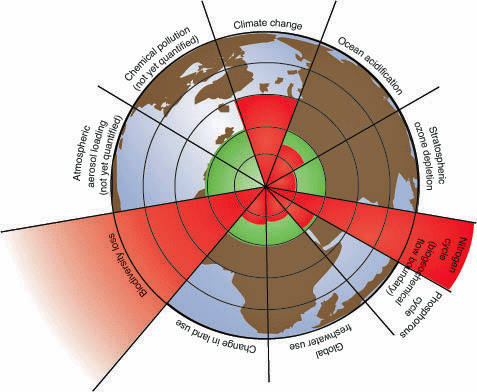
Nine planetary boundaries from 2009 (Azote Images/Stockholm Resilience Centre)
Three recently released studies are painting a grim picture for the future of humanity on planet Earth.
Professor Will Steffen from the Australian National University and the Stockholm Resilience Centre led some international scientists on two of the studies.
Their papers found that the impact of human activity on Earth, such as economic growth/globalization, population increases and energy use, for over the past 60 years, has sped up so quickly that we now are facing risks that are on “planetary-scale” proportions.
This impact of the accelerated human activity, suggested the papers, has also pushed our planet into a new geological epoch that some have named the Anthropocene.
The scientists said that four of nine global-scale processes that are impact life on Earth or ‘planetary boundaries’ have gone beyond safe conditions. Those four processes include carbon emission driven climate change, the loss of biosphere integrity, land-system change, and changes to biogeochemical cycles such as phosphorus and nitrogen runoff to the land and oceans.
The impact on two of those four processes – climate change and loss of biosphere integrity – has been so severe that they are now posing serious risks to our future well being and are pushing our planet into a new state.
“Human activities could drive the earth into a much less hospitable state – in this research we have more accurately assessed the risk of this happening,” said Steffen in one press release. “We are starting to destabilize our own planetary life support system.”
The accelerated impacts of human activity on the Earth (ANU Media)
The two studies – “Planetary boundaries: Guiding human development on a changing planet” was published in the journal Science and “The trajectory of the Anthropocene: The Great Acceleration” which was published in the journal Anthropocene Review.
The research team will also present the findings in their two studies at the World Economic Forum in Davos, Switzerland which runs from January 21 – 25, 2015.
The third study by Dr. Jan Zalasiewicz and Professor Mark Williams from the Department of Geology at the UK’s University of Leicester suggests that this new Anthropocene geological epoch and the “Great Acceleration”, discussed one of the previously mentioned studies, actually began on July 16, 1945 began with the Trinity Test, which was the first detonation the atomic bomb in New Mexico.
This first atomic blast (code named Trinity), a part of the Manhattan Project, marked the beginning of what has become known as the Nuclear or Atomic Age.
Zalasiewicz and Williams said that they believe that the day when humans first released an incredibly powerful new energy source with Trinity was also an important boundary in the history of Earth.
The researchers said evidence of this can be found through a number of clues that can be found in geological strata – levels of sedimentary soil and rock.
The two researchers said that since that day in July 1945 we humans have really been impacting our home planet which is changing its geology and creating new and distinctive strata that will continue way into the future.
The Zalasiewicz and Williams study, “When did the Anthropocene begin: A mid-twentieth century boundary level is stratigraphically optimal”, was published in the journal Quaternary International.






















Magneto-Sphere Disruption Science messing around with the magnetic fields of the earth.
Really interesting piece – I also found the original Steffen article “The trajectory of the Anthropocene: the Great Acceleration” free to access here:
http://anr.sagepub.com/content/early/2015/01/08/2053019614564785.full.pdf+html